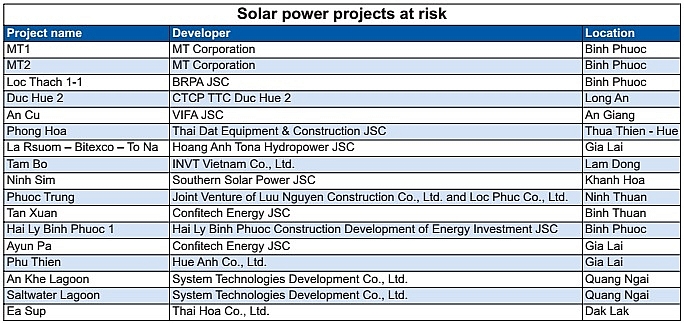Solar power ventures may lose FiT deadline race
 |
These projects (see chart) have been reported by the Ministry of Industry and Trade (MoIT) to have “completed appraisal” in Document No.10038/BCT-DL and Document No.10314/BCT-DL sent to the prime minister in December 2018.
All the details regarding their options for connection, capacity, and land use were addressed. In addition, these 17 projects are largely concentrated in the nation’s central region, where the transmission grid is considered to be overloaded. Notably, the common point among these projects is that they all have a capacity of 50 megawatts or less, meaning that these projects were under the jurisdiction by the MoIT before January 1. However, the ministry responded suddenly in February 2019 by saying “There is no basis for appraising additional planning or submitting additional planning to the prime minister for approval”. This raises questions of inconsistencies when evaluating the projects.
Local and foreign investors are racing to register solar power projects in Vietnam in order to reap the benefits of the feed-in tariff (FiT) of 9.35 US cents, which ends in June 30, 2019. There are no guarantees about pricing about connecting projects to the grid after this date. “How the FiTs are decided after June 30 this year will depend on technology prices at a specific period of time,” said Le Minh Duc, director of the Electricity Regulatory Authority of Vietnam’s Centre for Electricity Market Development and Workforce Training.
Furthermore, according to the Law on Planning taking effect in January 2019, the authority to consider and supplement the projects belongs to the prime minister and the evaluation is the responsibility of the Ministry of Planning and Investment.
What the stars mean:
★ Poor ★ ★ Promising ★★★ Good ★★★★ Very good ★★★★★ Exceptional
 Tag:
Tag:
Related Contents
Latest News
More News
- Efficient technology solutions key factors in energy transition (September 25, 2024 | 09:00)
- Sao Do Group gears towards energy savings (December 07, 2023 | 12:01)
- Vice President Vo Thi Anh Xuan visits Copenhagen Infrastructure Partners headquarters (November 23, 2023 | 10:37)
- A wind turbine tower collapses in China (November 20, 2023 | 19:36)
- Vietnam has massive potential for offshore wind energy (March 17, 2023 | 16:29)
- Rooftop solar event entices EPC contractors and investment funds (March 09, 2023 | 07:50)
- GreenYellow acquires 49.5MWp solar farm of French IPP Qair in Vietnam (November 25, 2022 | 08:00)
- Eaton contributes to Vietnam’s low-carbon economy (November 20, 2022 | 19:00)
- Proposals to promote Vietnam's energy transition (November 12, 2022 | 22:02)
- How intelligent lights make cities smarter, safer and greener (November 04, 2022 | 09:00)






















 Mobile Version
Mobile Version